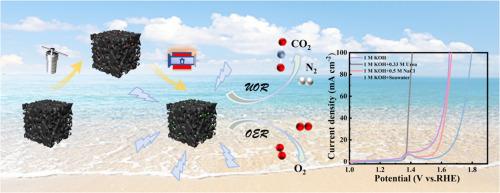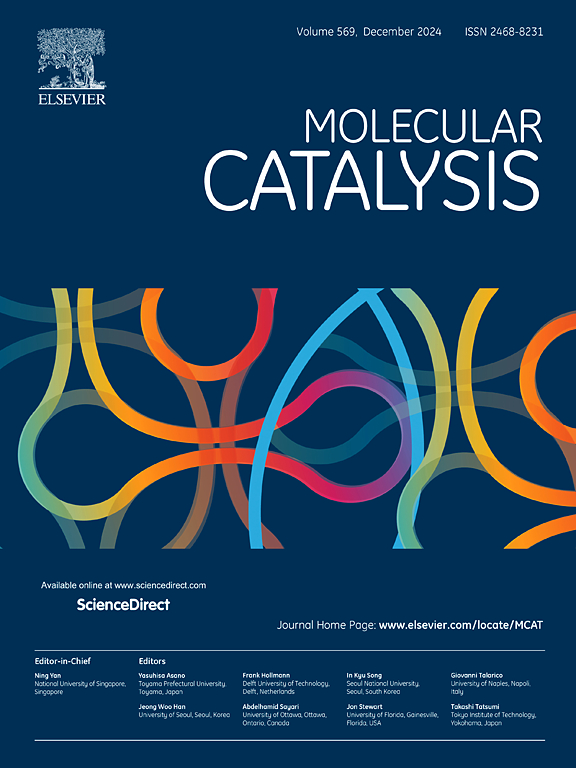生物基介孔碳修饰 Co3O4 量子点作为淡水、海水和尿素氧化反应的高效电催化剂
IF 3.9
2区 化学
Q2 CHEMISTRY, PHYSICAL
引用次数: 0
摘要
量子点(QDs)与碳材料的结合作为电催化剂因其卓越的催化活性和强大的热力学稳定性而备受关注。本研究利用生物基介孔碳作为碳源,通过水热法和碳化法合成了量子点碳纳米结构(Co3O4/BMC-400)。由于活性位点的丰富性和 Co 的有限性,Co 颗粒的大小被限制在 2 至 3 nm 的 QDs 水平。研究了 Co3O4/BMC-400 在淡水、海水和尿素中的阳极氧化反应。制备的 Co3O4/BMC-400 在 1.0 M KOH 溶液中,10 mA cm-2 时的氧进化反应过电位为 235 mV。由于海水中氯离子造成的竞争性氧化和腐蚀,催化活性降低。更重要的是,与 Co3O4 纳米片和纳米颗粒相比,QDs 能有效减少碱金属离子的传输途径,从而增加催化活性位点的数量,同时提高稳定性并延长使用寿命。这些发现有助于进一步探索金属-QDs/碳材料在电催化领域的广泛应用。本文章由计算机程序翻译,如有差异,请以英文原文为准。

Bio-based mesoporous carbon-modified Co3O4 quantum dots as efficient electrocatalyst for freshwater, seawater and urea oxidation reaction
The combination of quantum dots (QDs) with carbon materials has garnered significant attention as electrocatalysts owing to their exceptional catalytic activity and robust thermodynamic stabilities. The present study utilizes bio-based mesoporous carbon as a carbon source to synthesize QDs carbon nanostructures (Co3O4/BMC-400) through hydrothermal and carbonization methods. Due to the abundance of active sites and limited availability of Co, the size of Co particles is confined to the QDs level, ranging from 2 to 3 nm. The anodic oxidation reaction of the Co3O4/BMC-400 was investigated in freshwater, seawater, and urea. The prepared Co3O4/BMC-400 exhibits an oxygen evolution reaction overpotential of 235 mV at 10 mA cm−2 in 1.0 M KOH. The catalytic activity is reduced as a result of the competitive oxidation and corrosion caused by chloride ions in seawater. For the urea oxidation reaction, Co3O4/BMC-400 exhibits superior catalytic performance, requiring only a potential of 1.371 V at 10 mA cm−2, while exhibiting remarkable long-term stability for up to 30 h. More significantly, in comparison to Co3O4 nanosheets and nanoparticles, QDs can effectively reduce the transport pathways of alkali metal ions, thereby affording an increased number of catalytic active sites while simultaneously enhancing stability and prolonging service life. These findings may facilitate further exploration of metal-QDs/carbon materials in a wide range of electrocatalytic application.
求助全文
通过发布文献求助,成功后即可免费获取论文全文。
去求助
来源期刊

Molecular Catalysis
Chemical Engineering-Process Chemistry and Technology
CiteScore
6.90
自引率
10.90%
发文量
700
审稿时长
40 days
期刊介绍:
Molecular Catalysis publishes full papers that are original, rigorous, and scholarly contributions examining the molecular and atomic aspects of catalytic activation and reaction mechanisms. The fields covered are:
Heterogeneous catalysis including immobilized molecular catalysts
Homogeneous catalysis including organocatalysis, organometallic catalysis and biocatalysis
Photo- and electrochemistry
Theoretical aspects of catalysis analyzed by computational methods
 求助内容:
求助内容: 应助结果提醒方式:
应助结果提醒方式:


